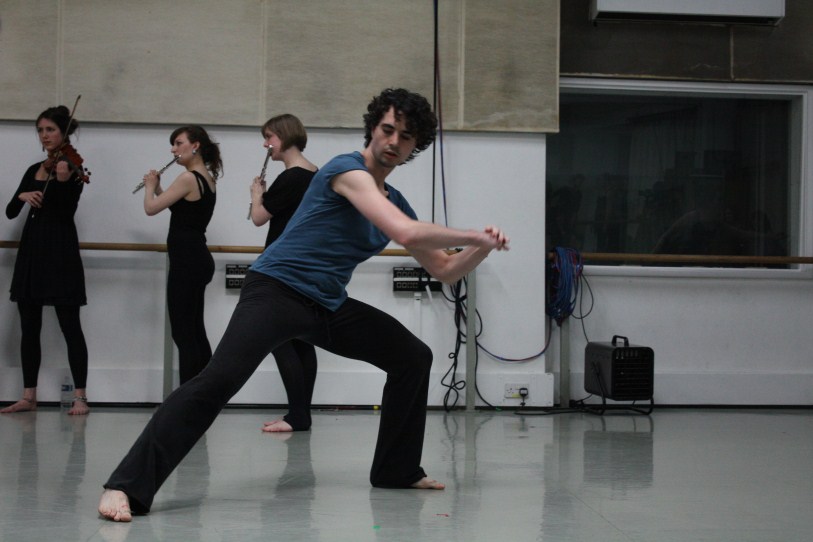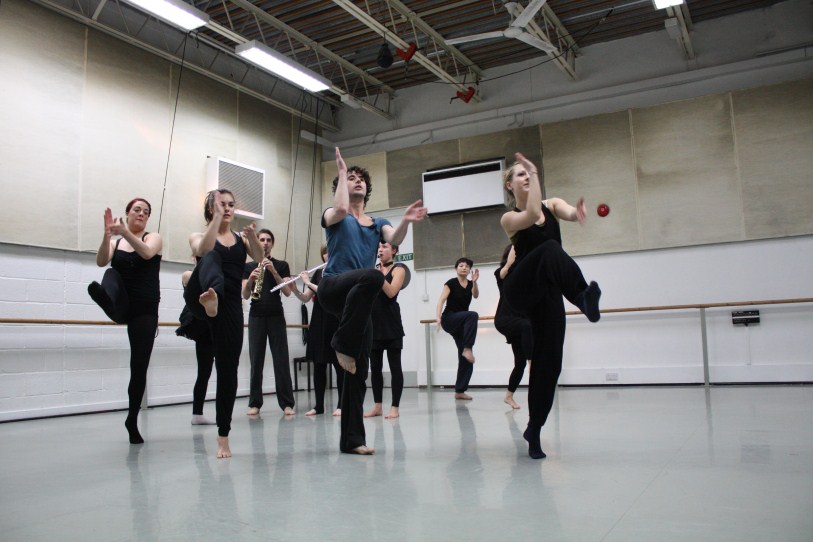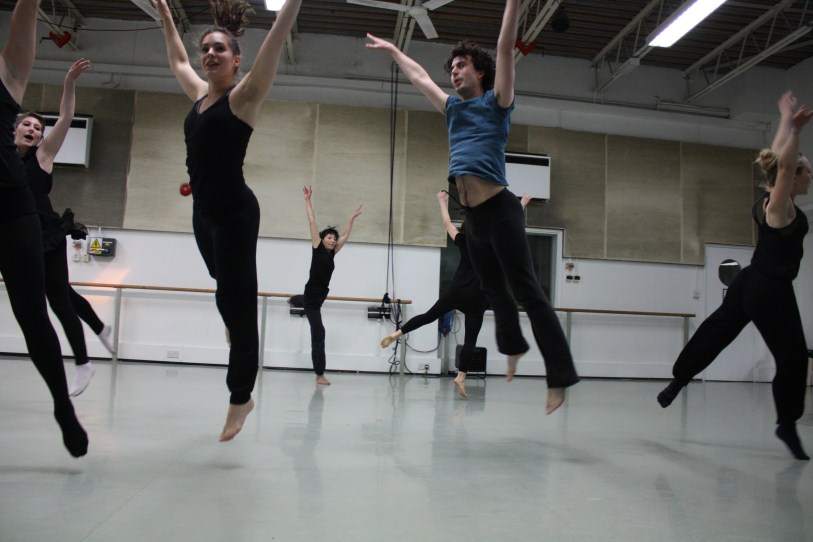- Details
-
Category: Reviews
-
Published: Thursday, 19 April 2012 00:57
-
Written by Chantal Guevara
The Place has long been the home of experimental dance and performance art, so it was only fitting that the opening night of Spring Loaded featured experimental works by Darren Ellis Dance and Robert Clark. Both works were shown in their very early stages last summer at The Place as part of the post-Choreodrome showings Touch Wood, and both have benefitted from extensive research and development as part of their choreographic process.
Darren Ellis's Long Walk Home was an exploration of four women at different ages and different stages, ranging from mid-teens to 70, working with Linda Lewcock from Company of Elders; Lauren Potter, formerly of London Contemporary Dance Theatre, Siobhan Davies and DV8; Jo Wenger (ex-Richard Alston Dance Company), and a DanceEast Academy student, Mari Hullet.
The piece sought to explore the hopes of each woman, with information passing through the generations, and so we saw an extended solo by each woman before stepping aside for a younger or older dancer's physical soliloquy. The eloquence of each dancer was enhanced by the improvised feel of each solo, from Linda Lewcock's rocking of a child to Jo Wenger's anxious attempts to hitchhike. While much of the dancers's stories were obscure, their performances were captivating, especially the awkwardness of Lauren Potter's solo and the intensity of Jo Wenger's.
Potter presented a trapped, anxious figure, resembling a broken puppet with disjointed limbs, moving haltingly and hesitantly. Her solo was powerfully reminiscent of Frantic Assembly's Lovesong, in both the movement style and storytelling. The only duet of the evening was between Potter and Wenger, at the start of Wenger's section, which saw Wenger trying to copy Potter's movements, changing them to suit her own style once Potter had stepped out of the light. Wenger was the most compelling of the four dancers, especially in the way she kept her gaze focussed on the audience despite her frantic movements.
All four dancers were accompanied onstage by the astounding Askew Sisters, two women performing folk music on accordion and violin, with amazing vocals by Hazel Askew: beautiful music to accompany a beautiful piece.
Long Walk Home contrasted sharply with Robert Clark's Badlands, which was in theory an awkward love story set in '50s America with cinematic influences. But in the style of experimental dance, and indeed many dance works, what the audience saw was very different, and the lines between dance and movement were blurred. The piece opens with an endearing nervous introduction by Victoria Hoyland (of Van Huynh Company, Hofesh Shechter, Clod Ensemble and James Wilton) followed by a passionate kiss with Jake Ingram-Dodd, after which the two characters disconnect from each other and lose themeselves in their own worlds. He sings Elvis, she sprinkles flour on top of a toy house in lieu of snow, and she wills him to die because "she doesn't love him, they never fell in love". As one of them says at the end, "it's a shit ending."
- Details
-
Category: Reviews
-
Published: Tuesday, 17 April 2012 13:19
-
Written by Chantal Guevara
It's normal to throw a party and to ask for specific presents when reaching a milestone birthday. But Bob Lockyer chose to go that little bit further for his 70th birthday: the presents he requested were new works commissioned by some of his friends - some of the most influential names in dance, and performed over two evenings, raising money for two charities close to his heart: Royal Philharmonic Society Drummond Fund and The Place’s Pioneering Fund. While few may know him by name, his work touched the lives as many in his 40-year career as director and producer of dance programmes for BBC television, and his role in setting up and contributing to the running of many dance organisations including Dance UK.
The advertised programme featured new works by Richard Alston and Mark Baldwin, with additional works commissioned by Wayne McGregor, Monica Mason and Siobhan Davies - a veritable treat for contemporary dance lovers! The result was a celebration of contemporary dance, with the eight bite-sized pieces ranging from five to ten minutes in length.
The evening opened with works from two final-year students: Drone, by Andy Macleman, in his final year at London Contemporary Dance School, followed by Papillon by Seb Golfin, a graduate-year student at the Royal Ballet School.
The first work, Drone, was one of the most impressive of the evening. Drone was a understated work which used simple movements and gestures to mesmerise the audience. Drone was of an impressively high standard: Andy Macleman is a choreographer to watch out for.
Papillon, commissioned by Royal Ballet's Artistic Director Monica Mason, featured the 2011 winner of the Prix de Lausanne, Mayara Magri. Nevertheless, his duet - about a man trying to distract his girlfriend from her book - felt very generic and while it was pretty to watch, it did not appear to have anything new or original to show. The "park musicians" - Rebecca Herman on cello and Andrew Saunders on piano - were a lovely touch, however.
Mark Baldwin's offering, 'Prayer', was a rare intimate performance for Rambert's dancers, in an abstract work for four women. Prayer was a succession of solos, toying with shifting weight and balance in isolation. As always with Rambert, the dancers are lovely to watch, especially in a work as abstract as Prayer.
The final work of the first half of the programme was The Way It Works Is This..., a work commissioned by Siobhan Davies and choreographed and performed by Charlie Morrissey. Exploring the earliest attempts to record movement photographically by Etienne-Jules Maray, using a stuttering voiceover, Morrissey sought to recreate the early processes and imagery of Maray's works, with frequent blackouts to suggest the capturing of photos.
Rob Binet, a young Canadian dancer, was appointed as a Choreographic Apprentice at the Royal Ballet in January; Lake Maligne, a solo created for Daniela Neuegebauer of Random Dance, showed a very different voice from his work for Draft Works in January, At The River Styx. While conforming to Wayne McGregor's trademark costume of a vest and briefs, the choreographic style was Binet's own, using beautiful, languorous movements, at time enacting the lyrics of the accompanying music. Although McGregor's influence became more pronounced towards the end of the piece, Binet's developing voice is interesting and confident - we hope we'll see much more from him.
Richard Alston was perhaps the most generous friend of them all, presenting not one but two new works, and also reviving an excerpt of Robert Cohan's 1989 work 'In Memory'. Isthmus, the first new piece, was a very playful work, with Alston's dancers endlessly leaping through the air in enthusiastic leaps to offbeat abstract music by Jo Kondo. At only four minutes in length, Isthmus was definitely too short!
Richard Alston Dance Company last performed Robert Cohan's 'In Memory' in last year's Dance Umbrella, and the excerpt performed in this programme worked well, offering the audience a taster of the work without introducing any of the work's more complex themes. In Memory is a phyiscally and technically demanding work for four men, a precursor of the current "boy bands" of contemporary dance, and his creative influence on Richard Alston was clear from stylistic similarities.
It's often rare in contemporary dance to see pieces performed more than once, so it was interesting to revisit In Memory after six months; the highlight of the extract was the passionate duet between Pierre Tapon and Nancy Nerantzi, although In Memory elicited impressive performances from each of the piece's five dancers: Nathan Goodman, James Pett, Liam Riddick, Pierre Tappon and Nancy Nerantzi.
As the final piece of the evening, Alston's Shuffle It Right (excerpt) was a jazzy number, working with radio performances of two of Hoagy Carmichael's earliest songs. With costumes evocative of the '20s, Shuffle It Right showed the company lindy hopping, with a fine duet between Pierre Tappon and Andres de Blust-Mommaerts, however without sufficient momentum from Carmichael's songs, the piece was somewhat halting. But it found its way to a rousing finale - a fitting end to an evening of celebrations.




